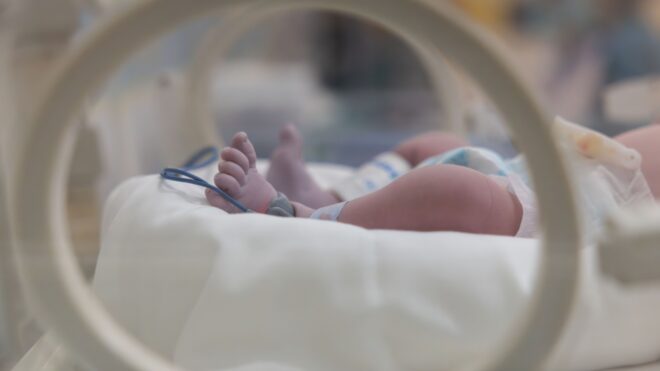A Georgia mom is doing her best to warn other parents after she says a popular sunscreen left her toddler with nasty chemical burns all over her face. Megan Doss told Good Morning America that it happened earlier this month after her family enjoyed a relaxing day at the lake. Just hours after applying an SPF sunscreen, which was marked safe for kids, her daughter's skin started erupting in red, swollen, blisters.
The mom first opened up publicly about what happened in an Instagram post she made last week.
In it, she admits some trepidation over even posting — in fact, she says she internally debated whether or not to for more than a week. But ultimately, she felt that the lesson her own family took from the experience is something others could benefit from too. And with that, she shared the tale with her 11,600 followers.
"Two Saturdays ago, I thought C had a weirdly-, rapidly-progressive sunburn," she wrote of her 3-year-old daughter, Caroline. "That day, we had applied/reapplied sunscreen as instructed and made her take breaks in the shade, so we couldn't figure out why she was so much worse than the rest of us."
It wasn't until several days later that Doss and her husband learned it wasn't a sunburn after all.
Instead, it was a chemical burn, the mom explained — one caused by the very sunscreen they'd put on to protect her.
As Doss later told GMA, she busily Googled sunscreen ingredients to see what kind of reactions they could cause. Still, she didn't realize the severity of the burns until she happened to take Caroline in for a pre-scheduled surgery for an unrelated condition.
It was there that doctors took a closer look and recommended she treat Caroline's skin with a gentle moisturizer.
Now that it's been a few weeks, the toddler is healed up and feeling better, but her mom couldn't let the incident go without warning others.
Doss has declined to share the name of the sunscreen that she used, but she wants to make parents aware of the dangers that are lurking in everyday sunscreens — even the ones labeled as safe.
"I'm not here to call brands out," she wrote in her Instagram post. "I'm not here to tell you to run to your cabinets and throw away all the sunscreen you currently have. I'm definitely not here to tell you not to protect your skin. I'm just here to say, please, do your research. Not all sunscreens marketed for babies and children are actually safe, and the most popular brands typically rank worst when you start looking into it.
"I didn't take pictures of the blisters because I was, honestly, so embarrassed I had let this happen to my baby (even though I know, in reality, I didn't do anything wrong)," she added, clarifying that the photo in her post was taken about four days after their day at the lake.
Doss has since done a lot of research into sunscreen, and a lot of it has been pretty eye-opening.
"It's obvious these companies know this is happening (I mean, they're being sued, you guys) and are unwilling to change the chemicals they use because it would be expensive and doesn't happen to the majority," she wrote.
To that point, Doss gets it from the companies' perspective.
"This won't happen to the majority of kids," she continued, "but just because they don't have a severe reaction doesn't mean it's okay for them to use, especially long-term — that's like saying just because you didn't have a wreck today, you don't need to buckle your kids in anymore."
To this mama, that's just not good enough.
Molly Stout, a dermatology resident with ABC News' Medical Unit, told 'GMA' that Caroline appears to have had contact dermatitis.
Contact dermatitis is "a red, itchy rash caused by direct contact with a substance or an allergic reaction to it," according to the Mayo Clinic. It isn't contagious or life-threatening, the website stated, but it can be painful to the touch, like Caroline's blisters.
Stout added that oxybenzone, also known as benzophenone-3, is the most common cause of contact dermatitis, and it is frequently found in popular sunscreens.
That said, the toddler's reaction could have been caused by a number of factors.
"[The cause is] everything from preservatives to fragrances to maybe dyes — especially in kids' sunscreens," Stout told the morning program.
Whatever the case, Doss' story is a reminder that just because a sunscreen is marketed to children doesn't mean that it's completely safe.
Yes — really.
That's why the Environmental Working Group puts out a list of safe sunscreens every year, just to keep parents and consumers informed. (Check the full, up-to-date list here.)
The good news? The US Food and Drug Administration is trying to do something about this (albeit very very slowly).
Last year, the FDA issued a proposal for new sunscreen guidelines that would restrict the kinds of chemicals used in common sunblocks on the market. The proposal came after multiple studies found that several harmful chemicals used in common sunscreens can be absorbed through the skin and into the bloodstream. (They included avobenzone, oxybenzone, octocrylene, and ecamsule.)
The agency, however, still seems to be working through its official guidance, and the proposed rules have not yet been finalized.
For now, Doss just wants other parents to know what she didn't.
"For every item on the market, there's a person out there who's had a reaction of some kind. I'm not oblivious to that fact. But using chemicals over and over again we would never go pick up from the store and rub directly on our kids just because they're mixed into a popular product doesn't make them safe," she wrote in her post.
"We can't protect them from everything," she continued, "but I feel like this is something that needs to be common knowledge."




